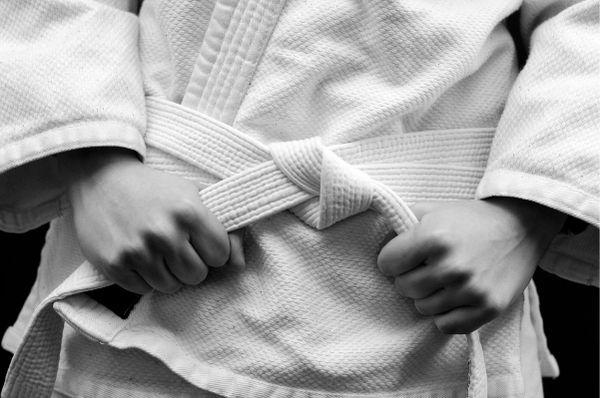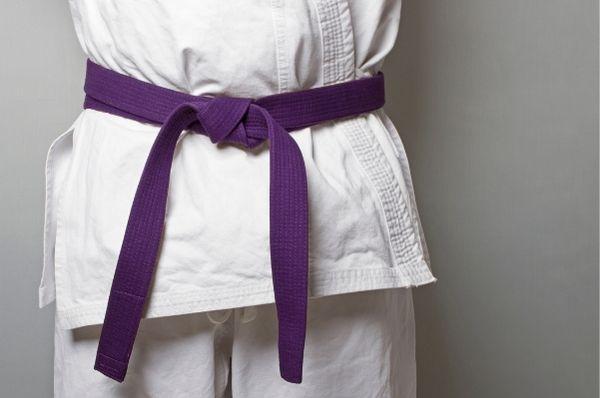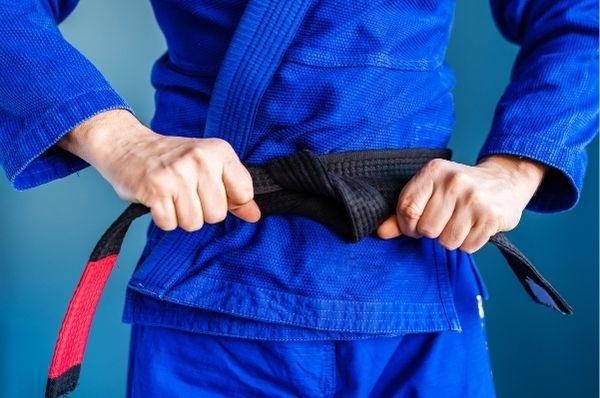Belt Levels in BJJ Written on . Posted in Brazilian Jiu Jitsu.

Belt Levels in BJJ
As with most martial arts, the Brazilian Jiu-Jitsu belt system can vary based on the school you attend, and under which professors you receive your training.There are also differences depending on whether your program is adminstered according to Helio Gracie system or the International Brazilian Jiu Jitsu Federation (IBJJF standard).
For BJJ martial artists, the belt system varies according to skill level, age, consistency, dedication, and commitment. It may seem that these factors are hard to measure, BJJ parctitioners learn in a highly relational environment. Generally speaking the professor will know the student well.

BJJ Belt System Overview
When it comes to belt color, for both the International Brazilian Jiu-Jitsu Federation and Gracie, you should expect to start out as a white belt level practitioner.
A new white belt comes as the default uniform BJJ belt and is the first belt that new students should expect.
The white belt could be worn for as little as 4 months or as long as up to 2 years before you can move to a new belt. First time jiu-jitsu practitioners should expect to spend quite a bit of time in a white belt as you learn the basic movements.
However, as you advance you may receive white stripes on your belt. You can read more about the white belt stripe system here.
Stripes on a white belt are not traditional by gracie, but if the school you belong to stripes belts as a sign of progress, you would expect up to earn up to four stripes before advancing to the next level.
The tradition of striping belts came about in the year 2000.
The original BJJ belts put together by Gracie in 1967 wer as follows:
-
White student
-
Light blue assistant instructor
-
Navy blue professor or instructor
At the time, you could go an entire lifetime of training and you would have still had a white belt.
Minimum Age Requirement
Generally speaking there is no age requirement to begin your training. However, according to the Gracie system, you must be at least 14 to take your combatives test and 16 to test for a blue belt.

Blue Belt Level
The next belt level after the white belt is the blue belt. According to the adult belt system BJJ practitioners move from the standard issue white belt to the blue belt.
To qualify for blue can take a long time, you should expect the minimum time to take 2-5 years or even up to 6 years. A blue belt practitioner is also sometimes referred to as “Street Ready.”
All belts up to brown belts could receive 4 stripes. This is simply to provide students with an outward sign of progression. It reduces the number of colors needed in the sport.
The gracie academy also offers a white and blue belt once students have completed 36 lessons. The belt features a blue stripe running down the center of the belt from end to end.

Purple Belt
Purple belt is the point at which the student has gone through the entire curriculum of a school and shows a decent level of proficiency.
Some consider student who reach the purple belt level as serious practitioners of BJJ. These BJJ students could also be considered “street proficient.” This phase can often last from 3-5 years.
With roughly 5-7 years of training to reach the purple level, the instructor considers the student committed and dedicated. During this phase it is about focusing on the weaknesses in the student’s fighting style. The goal is to work towards refinement.
In some schools, they no longer stripe at purple and above since the student is typically displaying a commitment to long-term Brazilian Jiu Jitsu and doesn’t require the same sense of progression that helps newer students.
BJJ would expect that a student in this phase trains any time they have free time.
Brown Belt Level
Brown Belt - In many ways from a technical perspective there may not be much obvious distinction between a brown belt and black belt’s ability. However, it is during the brown belt phase that the overal strategy and game of the student is looked at. The student will develop his own style to the highest level.
The focus is developing the game. Students can expect to remain a brown belt for 1-2 years. This depends really on how much well you have mastered each phase to this point.
The Esteemed BJJ Black Belt
.jpg)
In Brazilian Jiu Jitsu, you can expect to spend up to 12 years to achieve the status of black belt.
Though you are a black belt, it’s important to understand that bjj is ever evolving and there will always be new skills to master.
What is the difference between the black belt and the black belt with the white bar (wide white stripe)? Essentially, there is no difference. Some schools have a preference or may use one for competitions, however, there is really no difference.

What about the black belt with the red end? The red bar on a black belt can signify different things to different schools. It may be used to signify that you are an instructor. Generally speaking, the red has no real significance outside of what is agreed upon for that school.
There is an important distinction that although you may have achieved a black belt, it doesn’t necessarily mean that you would be a proficient instructor.
Maybe you don’t recognize how students should train to improve a specific skillset. However, if you choose to become an instructor, you can only award belts up to the belt under your highest achievement. In other words, black belts typically do not award black belts, they can award up toe a (4 stripe where practiced) brown belt.
Black belts historically were earned by training so long that naturally over time the black belt was so soiled they had turned black.
At the black belt level, the practitioner shows extreme proficiency. They typically take around 10 years to achieve, although it can be longer. Less than 10 years is also possible, but not common.
What are the stripes on a black belt for? They are typically awarded for years of instructing.
This is one example of how a school might award stripes.
If the black belt instructs for 3 years, you receive 1 stripe. If you teach for another 3 years, you get a second stripe. After another 3 years a third stripe. After 5 more years a fourth stripe.
Five years after that point, you may be eligible for fifth stripe.
Black belt wearers are typically referred to as professor.
- 3 years = 1 stripe
- 6 years = 2nd stripe
- 9 yeards = 3rd stripe
- 14 years = 4th stripe
- 19 years = 5th stripe
- 24 years = 6th stripe
- 31 years = 7th stripe / degree (coral belt) called Master
- 38 years = 8th stripe / degree (coral belt) called Master
At this point, historically, the black has worn down and the red starts showing. If you teach for another 7 years, you could be awarded your seventh degree black belt has sections of red in the belt.
Then after the 8th stripe, you move on to a red belt and are referred to as Grand Master.
IBJJF uses white and red as the 8th degree black belt which is similar to judo.
BJJ Red Belt
9th degree 45 years, red belt. This is the highest rank achievable.
Highly respected. Lifetime achievement.
Generally speaking the belts come in different weaves.
Highly respected. Lifetime achievement.
Generally speaking the belts come in different weaves.